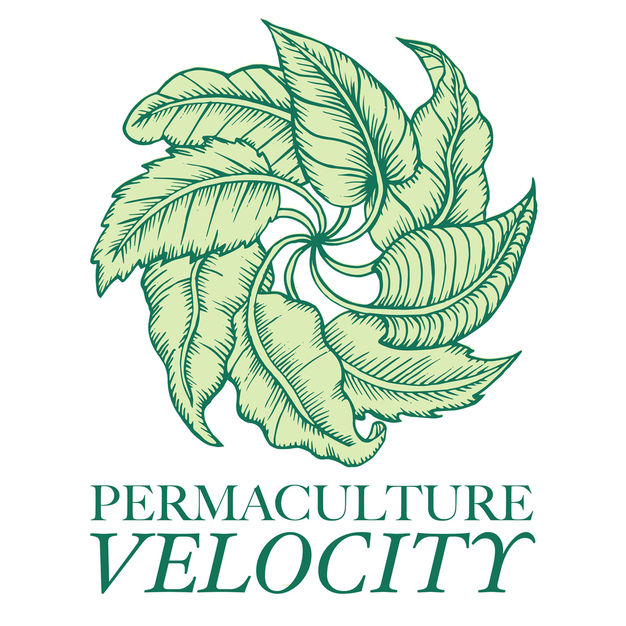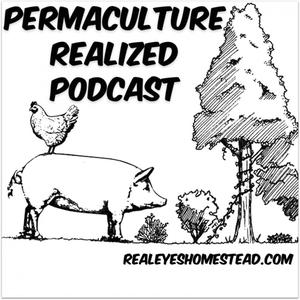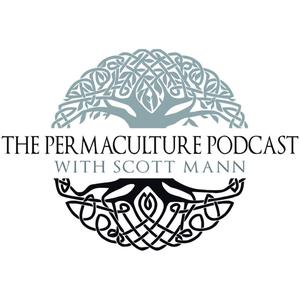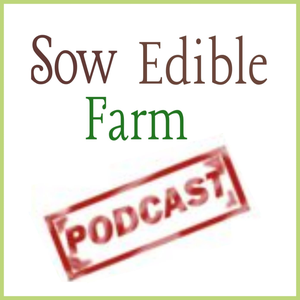
Permaculture Velocity | Homesteading Skills You Can Use
Soirée-Leone: Gardening & Composting, Canning & Fermenting, Chickens & Duc
Edible gardens. Chickens, geese, and ducks. Goats. Fruit trees. Fermented food. Pantry, root cellar, and freezer not grocery store. Slow food. Build it and fix it yourself. Connected communities. Permaculture by design transforms what was barren to productive.
- 6 minutes 42 secondsChoosing a Preservation Method—Canning or Freezing?
Freezing is quick and easy—I understand why folks are fans. Chop green peppers, put in plastic bags, and toss in the freezer. Blanch and peel tomatoes, pack in freezer-safe containers, and stash in freezer. No doubt that freezing has a place in a preservation kitchen. I prefer to use a freezer as one of several preservation methods and not rely on it heavily. A freezer failing would make me sad and freezers fail from time to time.
Instagram: Soirée-Leone Website: soireeleone.com
Producer: Marina Darling
Recorded in beautiful Hampshire, Tennessee
Try a Podcasting 2.0 Certified app: Podfriend - Breez - Sphinx - Podstation - Curiocaster - Fountain
In my freezer I stash, chopped bell peppers, tempe, bacon, some meats, blueberries, and pesto in small jars. Sometimes I freeze broth if I only have a few quarts and not enough to fire up the pressure canner. I rarely freeze leftovers as they take up valuable freezer space that I’d rather fill with bacon or pesto.
I prefer to pressure can rather than freeze. Meat, chicken, fish, broth, carrots, beans, tomato sauce, and so forth are ready to use—no need to remember to defrost. I seem to remember to defrost exactly when I would like to making whatever it is that is frozen. Jars of foods that can put food on the table quick—no defrosting required.
When I am canning I prefer to can tomato sauce and tomato paste so the food is ready to go in the way that I tend to enjoy it. Cooking down all the tomatoes at once rather than lots and lots of jars of whole or diced tomatoes. Tomato paste ready for adding rich tomato flavor or pizza night.
Canned beans—5-pounds of dried beans yield about 18 pints of canned beans ready to go.
Soup on the quick—broth, meat, vegetables, beans, fermented sour corn or kimchi, and perhaps some leftovers or sauté garlic and onions—dinner.
Whether freezing or canning be sure to label and apply first in, first out best practices.
29 July 2022, 1:34 am - 6 minutes 47 secondsTurmeric Paste Perpetual Ferment
Perpetual ferments like nuka pickling beds and pao cai are wonderful because they allow one to add and remove vegetables (and fruits) as needed to ferment then enjoy—fermented turmeric paste is another perpetual ferment.
I love having the turmeric paste around as we are a household of two and having one jar of paste around is perfect for adding a handful of vegetables to then enjoy. It’s perfect when you have a radish or an apple or a couple cucumbers.
The first step to all this convenient fermentation is to ferment the paste. Following Adam James’s lead in Sandor Katz’s Fermentation Journeys, combine 400 grams turmeric root, 400 grams turnips, 300 grams peeled garlic, and add 4% salt in a blender and blitz until it’s a paste. I found that using my food processor didn’t yield a paste.
I then fermented the paste in a 3 liter jar for nearly six weeks because I forgot—it was during winter so it would’ve taken a bit longer to be happy. I didn’t stir as the recipe indicated due to the same forgetfulness—there was some darkening on the top of the paste—but it was fermenting along happily and smelled terrific.
Now the turmeric paste is happy and ready to accept foods to be fermented. I found that I love the dramatic presentation of turnips, radishes, yellow or brown onions, grapes, apples, pears and Asian pears, and cucumbers. In the summer time they are usually tasty wonderful after 3 or 4 days—in the winter it takes a week or two.
I’ve found that if I need to add to the jar because the paste is running low or needs more salt, I make a half batch or so—adjusting the salt as needed—and add it to the existing paste. Stir and resume using the paste after a few days.
While I am sure that the creative culinary folks will have lots of ideas about using the turmeric paste for cooking or adding to other ferments, I always use it to get a curry kicked off. It’s more than half way there—sauté some garlic, ginger, etc. add the paste, and add a can or two of coconut milk. Done. Add tofu or meat if you like. Dinner on the quick along with some noodles or rice.
Instagram: Soirée-Leone Website: soireeleone.com
Producer: Marina Darling
Recorded in beautiful Hampshire, Tennessee
Try a Podcasting 2.0 Certified app: Podfriend - Breez - Sphinx - Podstation - Curiocaster - Fountain
20 July 2022, 8:46 pm - 6 minutes 6 secondsCare of the Homestead Septic Tank
Complete show notes: soireeleone.com/podcast
Recommended reading: Lloyd Kahn’s The Septic Tank Owner’s Manual. Shelter Publications, 2017. Or start with the tons of free information: https://oasisdesign.net/wastewater/septic/failure.htm
Some recommendations:
Use grey water friendly products. This is good practice to get ready for having a grey water system or moving to a rural area with a septic tank. The major consideration is sodium and boron (borax) as ingredients. Learn more about grey water: https://oasisdesign.net/greywater/ or https://greywateraction.org/greywater-faq/
Instagram: Soirée-Leone Website: soireeleone.com
Producer: Marina Darling
Recorded in beautiful Hampshire, Tennessee
Try a Podcasting 2.0 Certified app: Podfriend - Breez - Sphinx - Podstation - Curiocaster - Fountain
12 July 2022, 8:00 pm - 9 minutes 56 secondsGarden Happiness
Complete show notes: soireeleone.com/podcast
In 2008 there was flurry of folks starting gardens and again in 2020—both coupled with a run on canning jars. A gardener needs jars to put up the harvest—so do plan for a garden doing well—if not this year then next year. Buy canning jars and other preservation equipment and ingredients well ahead of canning season.
Instagram: Soirée-Leone Website: soireeleone.com
My garden book recommendations: https://www.soireeleone.com/resources/gardening
My favorite garden book:
Alys Fowler's Garden Anywhere: How to grow gorgeous container gardens, herb gardens, kitchen gardens, and more—without spending a fortune. Chronicle Books, 2009.
If you are in the Southeast U.S., I highly recommend:
Ira Wallace's Vegetable Gardening in the Southeast. Timber Press, 2013.
Producer: Marina Darling
Recorded in beautiful Hampshire, Tennessee
Try a Podcasting 2.0 Certified app: Podfriend - Breez - Sphinx - Podstation - Curiocaster - Fountain
5 July 2022, 8:00 pm - 10 minutes 11 secondsCheesemaking Philosophy & Learning to Make Cheese
I love cheesemaking. When I first learned to make cheese in 1991, I didn’t think or know that I should be scared or concerned about doing it wrong. I was raised with a can do attitude, just do it, learn, learn more, then down the road master it or at least be better at it.
There are risks but cheeses often tell us we screwed up. Bloated, bouncy cheeses are obvious for example. Off colors and undesirable textures and smells are also obvious. Quite unlike Clostridium botulinum, which causes botulism, hanging out with nary a sign of its paralyzing presence looming in a jars of home canned food, improperly cured meats, and so forth.
Absolutely employ good milking practices from a healthy herd, milk from a trusted source, attentiveness to cleanliness of the cheesemaking equipment, etc but beyond that I just jumped in and still jump in—I didn’t have anyone or the internet to warn me otherwise. With one thin cheesemaking book that I picked up used, I dove in.
Some of my first cheeses were from allowing milk to naturally clabber and junket rennet cheeses. I was so excited when I spotted junket rennet at the local Hy-Vee! I didn’t know about chymosin and pepsin and the difference between junket which is for making custards and legitimate cheesemaking rennet.
But, I made cheese and it was exciting. It opened up a whole world to me—a world that I love dearly to this day.
Instagram: Soirée-Leone Website: soireeleone.com
Recommend Reading
- Mastering Artisan Cheesemaking by Gianaclis Caldwell
This book is a master class in book form and I highly recommend this book. She also has another book Mastering Basic Cheesemaking but if you are ready to get in the fast lane then Mastering Artisan Cheesemaking is a great start.
Rather than mimicking cheeses from around the world; learn what makes all the different textures, flavors, and so forth. Make a cheese that is truly your own even if using commercial cultures.
It is difficult, perhaps impossible, to duplicate the famous cheeses or regional specialities as so much relies on those pastures, those dairy animals, that climate, those caves and aging spaces, those techniques, that equipment, that scale, and so forth. Be inspired by all those magical cheeses and make your very own.
- The Art of Natural Cheesmaking by David Asher
With a solid foundation in making cheese from Gianaclis you can make some amazing natural cheeses (no commercial cultures, non-GMO rennets or alternative rennets, natural wrapping, washing, brushing etc.) Make a cheese that truly represents your local terrior.
- And also check out Trevor Warmedahl on Instagram and prepare to have your mind blown! milk_trekker He also has a substack so check that out too.Thank you for sharing the wealth of your travels Trevor!
Producer: Marina Darling
Recorded in beautiful Hampshire, Tennessee
Try a Podcasting 2.0 Certified app: Podfriend - Breez - Sphinx - Podstation - Curiocaster - Fountain
28 June 2022, 3:00 pm - 11 minutes 36 secondsStocking the Homestead Pantry
Food is expensive and stocking the homestead pantry with bulk food, buying food on sale, and other strategies is a good thing—but pantry pest infestations can be devastating and expensive. In this episode I share my considerations for storing food and stocking up.
My favorite storage containers other than glass mason jars with metal lid and ring or fancy plastic lids like Mason Tops lids are Vittles Vaults. Vittles Vaults are made by Gamma 2 in San Diego. They are large food grade plastic containers (BPA-free) that are suitable for storing large quantities (50 pounds or more) of flours, grains, beans, etc.
Gamma Seals are made by the same company convert plastic pails and buckets into secure food storage containers. Vittles Vaults and Gamma Seals are widely available in the U.S. including farm supply stores, pet supply stores, home improvement stores, and internet retailers. The silicone gasket, lid, and ring can be replaced if required.
Good storage containers that are air and water tight not only protect foods from pests and moisture getting into the container but also contain an infestation from moving from container to container. Consider silica gel or other oxygen absorbers if you live in a humid climate. I use Wise Dry as the large pouches are great for Vittles Vaults and have indicator beads to quickly see if they need to be recharged and the smaller ones are suitable for smaller containers like half-gallon jars.
Try a Podcasting 2.0 Certified app: Podfriend - Breez - Sphinx - Podstation - Curiocaster - Fountain
Good food storage practice:
- Inspect the food and packaging. Some folks store grains and flours in the freezer for protection or to kill any insects that might be present prior to long term storage. I don’t have a large freezer but this is something to consider depending on your situation.
- Decant the food into a clean, air and water tight container. Many containers are not suitable for long term storage. Consider an oxygen absorber if you live in a humid climate or storage will be longer term (more than a month).
- Discard packaging (compost, recycle, fire starter, etc).
- Refrain from commingling container contents. My exceptions are pasta which I decant into clear bags to save space and store together in a Vittles Vault and commercially packaged and sealed mylar bags which I also store in together in a Vittles Vault.
- Label with contents and date.
- Rotate inventory if needed, adhering to the first in, first out rule.
- Store in a dark and cool location.
21 June 2022, 2:00 pm - 7 minutes 33 secondsDitching Urban Life
After a multiyear hiatus, Soirée is back and switched things up. Permaculture Velocity is now Soirée with The Sauce.
In this episode I share why we moved to rural Tennessee from San Diego and some of the big considerations if you are thinking about ditching the urban grind and moving to the country.
Try a Podcasting 2.0 Certified app: Podfriend - Breez - Sphinx - Podstation - Curiocaster - Fountain
Thank you Mara Jane King for suggesting “the sauce” as that spurred the podcast name change that was long overdue. xoxo
The sauce isn’t really a saucy sauce but a tasty, umani punch of flavor, dry seasoning blend of dehydrated natto, sesame seeds, chili pepper, salt, and sichuan peppercorns inspired by douchi from Mara's travels with Sandor in China.
Watch the eight films from their trip People's Republic of Fermentation with filming by Mattia Sacco Botto.
Later back in Tennessee, after their most excellent trip, (seriously watch the films!) I watched as Mara lovingly pulverized the ingredients in a mortar and pestle, blended and tasted, and poured the special sauce into a honey queenline jar. Amazing and delicious!
There are countless riffs, I’ve added dehydrated sour corn, finely grated salted goose egg yolks, and fried and dried tempe—though not all in the same blend. You can find more details about special sauce in Sandor Katz’s book Fermentation Journeys.
Producer: Marina Darling
Recorded in beautiful Hampshire, Tennessee
15 June 2022, 1:15 am - 9 minutes 22 secondsThe Best Breeds for the Backyard Flock - PVP44
Of all the chicken breeds, which are good choices for a backyard flock?
Show Notes: PermacultureVelocity.com
5 February 2016, 2:00 pm - 10 minutes 28 secondsUnderstanding Seeds: Heirloom, Open Pollinated, & F1 - PVP43
So many seeds, so many misunderstandings!
Show Notes: PermacultureVelocity.com
3 February 2016, 2:00 pm - 17 minutes 46 secondsMaking Salves, Creams, & Lip Balms - PVP42
Some products require special equipment, fancy ingredients, and so forth. These simple products are easy and economical. Each can easily be made as fancy as you like!
Show Notes: PermacultureVelocity.com
29 January 2016, 2:00 pm - 12 minutes 10 secondsThe Best Pressure Canner for the Homestead - PVP41
Getting ready to preserve the summer's bountiful harvest means having the equipment on hand.
What's the best pressure canner to get the job done?
Show Notes: PermacultureVelocity.com
27 January 2016, 2:00 pm - More Episodes? Get the App
Your feedback is valuable to us. Should you encounter any bugs, glitches, lack of functionality or other problems, please email us on [email protected] or join Moon.FM Telegram Group where you can talk directly to the dev team who are happy to answer any queries.
 Permaculture Realized Podcast
Permaculture Realized Podcast
 Regenerative Skills
Regenerative Skills
 The Permaculture Podcast
The Permaculture Podcast
 Homesteading and Permaculture by Paul Wheaton
Homesteading and Permaculture by Paul Wheaton
 Farm Small Farm Smart Daily
Farm Small Farm Smart Daily
 Sow Edible Podcast
Sow Edible Podcast